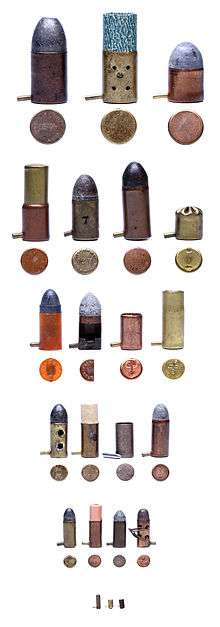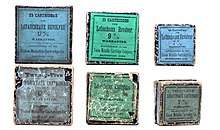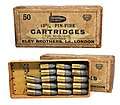Pinfire cartridge
A pinfire cartridge is an obsolete type of metallic firearm cartridge in which the priming compound is ignited by striking a small pin which protrudes radially from just above the base of the cartridge. Invented by Frenchman Casimir Lefaucheux in the 1830s[1] but not patented until 1835,[2] it was one of the earliest practical designs of a metallic cartridge. Its history is closely associated with the development of the breechloader which replaced muzzle-loading weapons.

History
The Swiss gun maker Samuel Joannes Pauly patented the first breechloading cartridge in 1812.[3] This was for use in a shotgun with fixed barrels which was loaded by lifting a breech block on the top. French gun maker Henri Roux attempted to improve this cartridge in the 1820s but a constantly primed cartridge was felt by many to be too dangerous and many breechloading guns reverted to using an unprimed cartridge. This was fired by a separate percussion cap which was used on the still dominant muzzle-loading guns.
Casimir Lefaucheux of Paris decided in 1832[4] to patent a breechloader where the barrel hinged downwards to reveal the breech ends. These still used a separate percussion cap. Though used before this, (as seen in surviving pinfire shotshells that lists the names of early gun makers he signed contracts with in 1833 and 1834,)[1][5] in 1835[2] he was granted an addition to the 1832 patent for a new type of cartridge in which the cartridge's priming compound is ignited by striking a small pin which protrudes radially from just above the base of the cartridge. These pins fitted into a small groove cut in the top of each barrel-end and made it easy to see if the gun was loaded. The cartridge used metal bases (often brass) with paper tubes which were usually loaded by the shooter or his staff but were not entirely gas-tight. This reduced the force of the charge and allowed powder residue and gas to escape.
The pinfire cartridge was greatly improved by the 1846 patent (number 1963) by Benjamin Houllier of Paris which introduced a base wad and effectively made the cartridge gas-tight which greatly improved the performance. They were cheap and clean shooting. These improved pinfire guns grew in popularity in France and some were imported by British gun makers to overwhelming indifference on the part of the gun users there. They were prejudiced technically against a gun that 'broke' in the middle, despite the much vaunted benefits of breechloading. They owned muzzle-loaders of exquisite perfection, considered themselves the best engineers in the world (inventing the Industrial Revolution), and had a poor view of the French - the old enemy and an unreliable ally.
It was not until the Great Exhibition of 1851 was held in London that breechloading guns were taken more seriously by British and American gun makers in particular. The display of a Lefaucheux breechloading gun inspired English apprentice gunmaker Edwin Charles Hodges (1831-1925) to make an improved copy and persuade leading London gun maker Joseph Lang that this was the gun of the future. Lang was universally credited to be the first established British gunmaker to produce pinfires in any numbers. His first weapon of this new type was produced in 1853. Other British gun makers including Lancaster, Blanch and Reilly were similarly inspired by French originals and improved pinfire breechloaders became the new type of gun which by 1857/8 every fashionable British prince and titled gentleman wanted to have. EC Hodges continued to make a good living as a specialist independent maker of breechloading actions commissioned by leading gunmakers such as Boss, Lancaster, Egg, Grant, Atkin, Rigby, Dickson, Purdey, Woodward, Army and Navy, and many others.
After Casimir's death in 1852, his son Eugene continued to market the pinfire design with great success. It became increasingly popular in Europe and large numbers of shotguns and revolvers (often called Lefaucheux guns after their inventor whoever the maker was), were manufactured from the mid-1850s until the 1890s. They were quicker and easier to load than percussion weapons with loose black powder, percussion caps and bullet; and they were also much more likely to fire reliably when wet. Pinfire cartridges were available in a large number of sizes for various types of weapon.
While pinfire shotguns declined from the early 1860s after the introduction of mass-produced centerfire shotgun cartridges, pinfire revolvers in particular became very successful and widespread, being adopted by the armies of France, Italy, Spain, Switzerland, Sweden and others. They were also used during the American Civil War, although sometimes despised because of their low power compared to Colt and other percussion revolvers. Some navies also adopted them, "sea service" examples often being made out of brass which is largely unaffected by the corrosion caused by salt.
Pinfire became obsolete once reliable rimfire and centerfire cartridges became available because without a pin which needed aligning in the slot in the chamber wall they were quicker to load. They were also safer because they had no protruding pin which could cause the ammunition to accidentally detonate during rough handling, particularly of loose ammunition.
American manufacturers
- Ethan Allen & Co.[6] of Worcester, Massachusetts
- Allen & Wheelock[6] of Worcester, Massachusetts
- C.D. Leet & Co.[7] of Springfield, Massachusetts
- C. Sharps & Co.[8] of Philadelphia, Pennsylvania
- Union Metallic Cartridge Company[9] of Bridgeport, Connecticut
- William Tibbals[10][11] of South Coventry, Connecticut
 Pinfire Cartridge Box by Ethan Allen & Co.
Pinfire Cartridge Box by Ethan Allen & Co. Pinfire Cartridge Box by Allen & Wheelock & Co.
Pinfire Cartridge Box by Allen & Wheelock & Co. Pinfire Cartridge Box by C.D. Leet & Co.
Pinfire Cartridge Box by C.D. Leet & Co. Pinfire Cartridge Boxes by Union Metallic Cartridge Company
Pinfire Cartridge Boxes by Union Metallic Cartridge Company
British manufacturers
- Eley Brothers[12] of London
- Kynoch & Co.[13] of Birmingham
 Pinfire Cartridge Box by Eley Brothers
Pinfire Cartridge Box by Eley Brothers Pinfire Cartridge Box by Kynoch & Co.
Pinfire Cartridge Box by Kynoch & Co.
Current status
Although pinfire cartridges and shotgun shells are technically obsolete, as pinfire guns have not been made in any numbers for a hundred years, enthusiasts of vintage weaponry often make pinfire cartridges from modern materials and shoot their old guns. As regards pistols, some modern novelty miniature guns are manufactured in very tiny calibers, such as 2mm. Although not practical weapons, they use pinfire ammunition because the caliber is too small for centerfire or rimfire. Antique pinfire firearms and cartridges are available on the collector market and modern reloading kits exist which contain specialized cartridges which can be hand loaded, though the process is far more complex than for centerfire cartridges.[14]
See also
Notes
- Newcomer, Aaron (March 2014). "The Pinfire Page". International Ammunition Association Journal (496): 72–74.
- FR patent 6348, Casimir Lefaucheux, "fusil se chargeant par la culasse, au moyen d'un mécanisme qui fait basculer le canon", filed 1835-01-08, issued 1835-03-31
- "The First Cartridge; A History of Jean Samuel Pauly and His Inventions". FMC. 2018-11-23. Retrieved 2018-12-19.
- FR patent 5183, Casimir Lefaucheux, "fusil se chargeant par la culasse, au moyen d'un mécanisme qui fait basculer le canon", filed 1832-06-16, issued 1833-01-28
- Gérard., Lautissier (1999). Casimir Lefaucheux, arquebusier : 1802-1852. Renonciat, Michel. La Tour-du-Pin: Éd. du Portail. ISBN 2865510409. OCLC 48221554.
- "Cartridge Manufacturer, Allen & Wheelock". freemycollection.com. Retrieved 2018-12-28.
- "Cartridge Manufacturer, C. D. Leet". freemycollection.com. Retrieved 2018-12-28.
- "Cartridge Manufacturer, C. Sharps & Co". freemycollection.com. Retrieved 2018-12-28.
- "Cartridge Manufacturer, Union Metallic Cartridge Company". freemycollection.com. Retrieved 2018-12-28.
- Newcomer, Aaron (January 2019). "The Pinfire Page". International Ammunition Association Journal (525): 14–15.
- US patent 55743, Tibbals, William, "Improvement in Revolving Fire-Arms", issued 1866-06-19
- "Cartridge Manufacturer, Eley Brothers". freemycollection.com. Retrieved 2018-12-28.
- "Cartridge Manufacturer, Kynoch & Co". freemycollection.com. Retrieved 2018-12-28.
- "To Shoot My Pinfire" by Darrel G Dennis in Bob Bell, ed. (1997). Handloader's Digest (17th ed.). Iola, WI: DBI Books. pp. 194, 195. ISBN 0-87349-192-0.